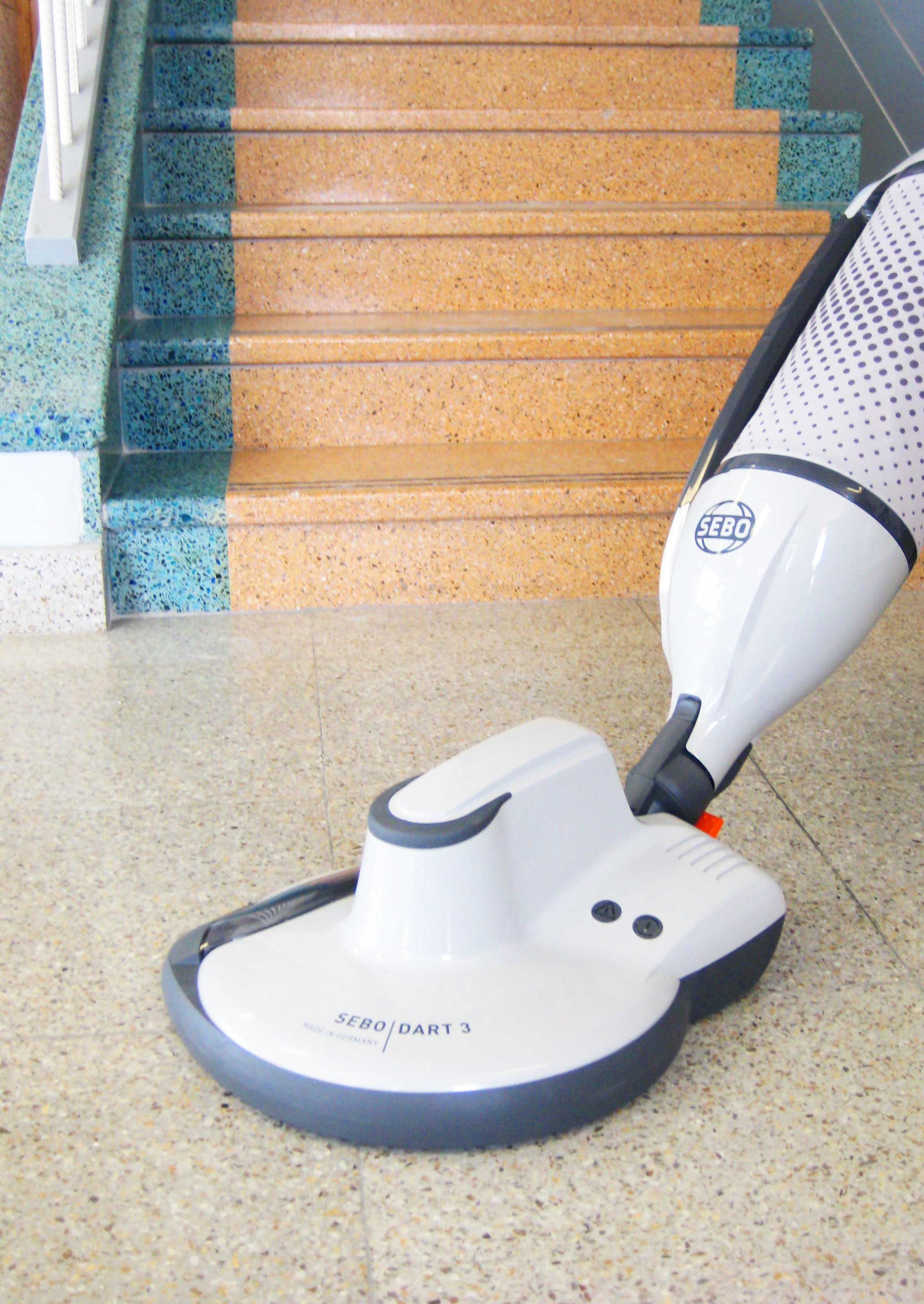-
Introduction
-
Carpet Care
-
Regular Maintenance
-
Carpet Cleaning
-
Hard Floors
-
Solid Wood
-
Laminate
-
Ceramic and Stone
-
Lino and Vinyl
Introduction

The flooring we choose has become an integral part of the decor of our homes.
A huge choice is available – from wool or synthetic carpets and rugs through to solid or engineered wood floors, an array of laminates, ceramic to natural stone tiles.
And then there is the spectacular choice of plastic flooring now available too, not to mention glass, rubber, cork, even leather.
Some households easily have up to three or more of the above – all with their own cleaning requirements. Regular cleaning will help maintain the quality and look of all flooring – and we hope this guide to flooring types and their correct care will help make a contribution to keeping your home clean and beautiful.
There are a number of steps you can take to protect and prolong your floors which are applicable to any flooring types:
- Check with the flooring supplier or manufacturer as to the recommended care.
- Use entrance mats to prevent damaging dirt from entering the home.
- Vacuum regularly to remove dust and grit with the correct vacuum for floor type.
- Clean spots and spills immediately before they can stain.
- Do not use outdoor shoes indoors. Use indoor footwear such as slippers.
- Place rugs in heavy use areas to protect the floor.
- Clean a test patch first. If you are unsure, take professional cleaning advice.
- Refer to the Australian and New Zealand standard AS/NZS 3733 – Textile floor coverings – Cleaning maintenance of residential and commercial carpeting.



Back to top
Carpet Care
Types of Carpet
There are many types of carpet, generally though falling into one of two types, cut pile or loop pile. These are made from either wool or man-made fibres such as polypropylene or nylon or mixtures of fibre types. Fitted carpets made of sisal, or similar, are also available. It is important that you are aware of the carpet type/s you have, as this can have major implications for care and maintenance.
Cut Pile

Cut is a type of carpet which has been sheared so that the tips of the fibres form the surface, rather like upright bits of string. There are variations like twist and velvet (or velour). For durability, ease of cleaning and keeping its appearance, twist pile carpet is generally considered the best, which probably explains its popularity! An upright vacuum cleaner will bring up the pile most effectively. Velvet carpets (and to a lesser extent Saxony) can look beautiful, but have the disadvantage of showing footprints and vacuum cleaner tracks, etc. Check out SEBO X7 Boost for Plush Pile Carpet Care.
SEBO Upright Range
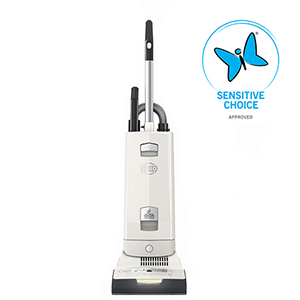
|

|
Loop Pile

The surface is formed of upright loops and can be one of the most appealing looking carpets, but can also require careful maintenance. Because it is looped the edge of the fibre forms the surface, so wear can affect its light reflection properties and it can absorb stains more easily. Wool loop demands the most care. Typically manufacturers advise to vacuum with the brush roller switched off as an abrasive bristle may cause it to fluff up forming a fuzzy surface, which is known as pilling.
However, with wool loop carpets even the Velcro ‘lint picker’ on a combination head can cause pilling. If you are considering purchasing this type of carpet, please establish its suitability for the area to be fitted and type of vacuum cleaner that you should be using as it may be different than the one you already have. SEBO has developed a delicate floor brush roller is available for their uprights and barrels fitted with a powerhead. It is recommended for use by wool loop carpet manufactures in conjunction with suction cleaning.
SEBO Barrel Range
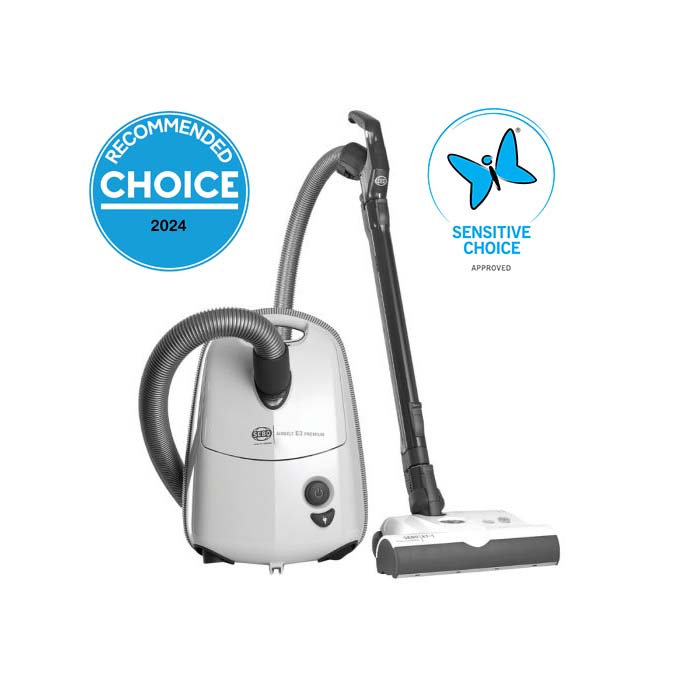
|

|

|
Delicate Brush Roller
Back to top
Regular Maintenance and Care
Colour is very important to achieve the desired look for the home, but the choice of colour can affect care and maintenance. Light coloured carpets, especially white ones, will mark very easily and conversely fibre will show up on black carpets. The optimum colours for long term appearance are mid to darkish browns or ones with a speckled pattern.
New carpets
With a little care and attention you will be able to greatly prolong the life of your carpet and keep it looking its best. Many people believe that when a carpet is new it should not be vacuumed. In fact you should vacuum straight away. You may be surprised how much fibre is vacuumed out and your carpet may also "shed" fluff for some time after fitting. This is caused by short lengths of loose fibre left over from the manufacturing process and is not the carpet disappearing! When a new cut pile carpet is vacuumed sometimes a few single tufts or loose ends stand above the pile. This is called sprouting and is quite normal. Tufts that are longer than the others are compressed in the pile and are lifted up by vacuuming. Don't pull them as this could damage your carpet so contact your carpet retailer for guidance.
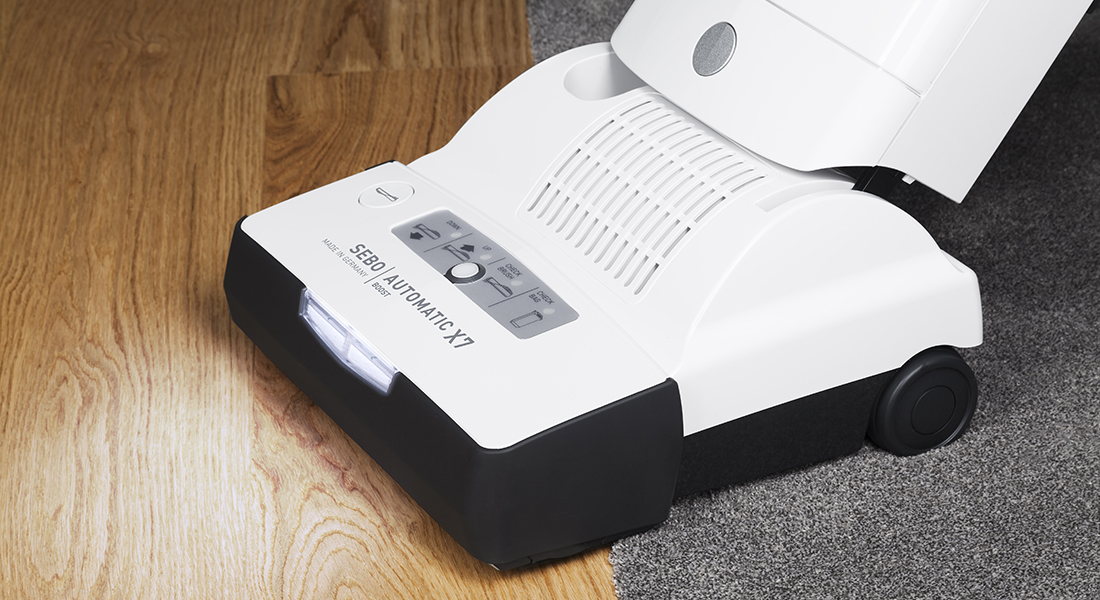
Vacuuming
Dirt and tiny pieces of grit from outside become trapped in the carpet pile. As the carpet is walked on these particles are crushed against the fibres and can cause premature wear. Entrances and other heavily used areas should ideally be vacuumed daily. Other areas need less attention but should still be vacuumed weekly.
Entrance mats*
Keeping soil away from your carpet is recommended to maintain its appearance and value. Use entrance mats to remove dirt and grit before it comes into the home. This not only keeps your carpet looking cleaner, it also helps protect the fibres from abrasion and dulling. Entrance mats need to be large enough that a few steps are taken on them when entering the home. Vacuum them regularly and if necessary clean them with a product such as SEBO Duo-P to ensure they do not become a source of dirt.
Rugs*
Consider using rugs in areas that receive particularly high wear, such as in front of chairs or sofas. People shuffling their feet when sitting can damage the pile of the carpet causing wear, flattening and dullness. This effect, known as "TV shuffle", can be prevented using rugs.
Footwear
Outdoor shoes will bring in dirt, tear at the pile of your carpet, and being hard soled, crush the pile against any hidden grit –causing much greater wear than indoor slippers.
Sun
Carpets can be discoloured and even damaged by exposure to direct sunlight. Protect them by closing curtains or placing a light coloured rug over the exposed area and avoid choosing carpets with any red colouration for a sunny room.
* Some rubber backed mats contain softeners to keep the backing flexible. This chemical can permanently stain your floor, an effect knows as anti-oxidant staining. Use a non-staining vinyl backed mat or a rug that is colourfast.
Back to top
Carpet Cleaning
Stains
If you have the misfortune to spill or drop something on your carpet clean it up immediately, as this can help stop a spill becoming a stain.
Spot Cleaning - Top Tips



1. Take action Immediately on discovering the stain. The longer it is left, the harder it is to remove.
2. Soak up liquids using white kitchen roll or white toilet roll. Using coloured material could further stain the carpet. Keep blotting until nothing appears on the paper when pressure is applied.
3. Use a spoon to scrape off solids. The more solids (and liquid) that can be removed, the more effective the cleaning chemicals can be.
4. Always work from the edge of the stain inwards.
5. If you don't at first succeed -the stain may still be removed by repeating the cleaning process over the course of a few days.
Most stains can easily be removed by SEBO Duo-P. However some may need a different treatment.
Carpet Cleaning
The requirement for cleaning is much reduced if the preventative steps outlined above are taken. However eventually it will become necessary. Most soiling types can be removed by brushing in SEBO Duo-P cleaning powder with the DUO Applicator machine. However, if the soiling is very bad, or involves difficult to remove stains, please contact a reputable professional cleaning organisation.
duo•P One idea – many advantages
A cleaning system with no unpleasant odours, no waiting time for drying, no shrinkage, just excellent results. Endorsements from the GAF allergy research centre in Germany, The British Woolsafe Organisation and Sensitive Choice - National Asthma Foundation Australia make duo-P the intelligent choice for those with dust allergies or wool carpets.
duo•P is made from thousands of micro-sponges. As duo-P is brushed into the carpet pile or upholstery fibres, a cleaning solution in the sponges dissolves the dirt which is then removed when the duo-P is vacuumed out.

|
 Duo-P Bulk Refill Duo-P Bulk Refill |
 Duo-P Clean Box Duo-P Clean Box |
The DUO
For effective spot, carpet and upholstery cleaning - without water. The DUO's contra-rotating brushes open up the carpet pile and allow the duo-P carpet cleaning powder deep into the carpet pile and around all of its fibres for optimum cleaning results.
Back to top
Hard Floors
The alternative to carpet is a smooth floor, otherwise known as hard floor. Hard floors come in many different types and each type can have a great many variations, so it is particularly important to contact the flooring manufacturer or supplier to get specific advice.
Hard floors, although generally durable and hard wearing, are not immune to damage and still require care and maintenance, much like carpets.
Generally, a very important factor with hard floors is to ensure they are sealed. A seal forms a protective surface and prevents liquid (and therefore stains) from penetrating. There is a simple test that can be performed to check if your hard floor is sealed correctly: Pour a drop of water onto the surface and spread it out with your finger. If the water is absorbed then the surface is in need of sealing as soon as possible. However, if the water beads and is repelled then your surface is properly sealed.
Entrance matting
The importance of entrance mats in protecting floors cannot be over emphasised. Dirt, grit and sand cut into the finish, causing scratches and dulling. Once the protective surface has been penetrated, liquid can stain the floor causing further problems.
Floor protectors
Place felt floor protectors on table and chair legs and the feet of any other furniture to prevent scratching. Rugs As with carpet, place rugs in high wear areas such as in front of sofas, which will be much more comfortable too! A rug is also a good idea for areas of your floor that are likely to come into contact with water, for example by a bath or sink.
Vacuuming
Vacuuming is essential, not only to remove any dirt and grit which has made it past your entrance matting, but also to remove any dust generated from within the home. Entrances and other heavily used areas should ideally be vacuumed daily. Upright vacuum cleaners are available which can clean both hard floor and carpet, such as the SEBO X range, but if the floor is uneven or delicate a barrel or SEBO Felix upright fitted with a parquet brush or combination head should be used. A delicate floor brush roller (5010GE) is available for SEBO uprights which may be suitable.
Polishing
For gloss hard floors consider investing in a polisher. If the floor is completely smooth a polisher such as the SEBO UHS Polisher can bring an hygienic shine to the surface, making the floor look like new. As it works in conjunction with the Felix Premium upright vacuum cleaner, the E3 Premium, K3 Premium, D9 Professional vacuum cleaners and Dart 2 Commercial vacuum cleaner you can vacuum and polish at the same time.
Spills
Mop them up before they can be absorbed into the floor!
Mopping
Wet mopping is normally best avoided, especially if the protective finish is worn. Use a specially formulated cleaning solution and take care to keep the mop damp rather than wet.
Back to top
Wood Flooring Care

There are many types of wood flooring; various hard or soft wood species are used and even bamboo (although strictly this is a grass). Solid wood or engineered composite ‘planks’ are available and the surface can either be, lacquered, oiled or waxed. Raw wood can also be used, but a protective surface finish is necessary to maintain the floor quality and so raw wood is not covered by this guide.
General care and maintenance of each type will be similar, a different approach only being required when restoration of the surface is required.
Soft wood - usually sanded and sealed floorboards - is much more prone to damage than hardwood and so will need more care and attention. However, as even hard woods like oak are susceptible to scratching and damage, no wood floor will remain pristine.
By following the preventative measures covered above you will greatly prolong the look of your floor and minimise the chances of damage.
A good source of information on all things relating to wood is the NSW Department of Primary Industries.
Wood Floor finishes
There are three types of finish; polyurethane, oil and wax. Each is cleaned in a similar way, but how you restore the surface depends very much on which finish you have.
Polyurethane: This is effectively a layer of plastic which protects and seals the wood. It is by far the most common sealant used today. Never apply oil or wax to polyurethane. For an optimum gloss surface use a polisher fitted with diamond pads.
Oil: The wood is impregnated with natural oils to give a water resistant finish. To maintain the finish re-apply the specified oil product. For an optimum gloss surface use a polisher fitted with standard (in conjunction with further oil treatment or diamond pads).
Wax: Sometimes considered a contentious treatment for hardwood floors, adding wax to your hardwood floor can improve its look relatively quickly. Wax is easy to clean and buff. It is also easy to add wax to continuously improve the look of your hardwood floor. However, an excessive build up wax may be difficult to remove. Also wax must never be put on an oiled or polyurethane surface. For an optimum gloss surface use a polisher fitted with standard pads.
Back to top
Laminate Flooring Care
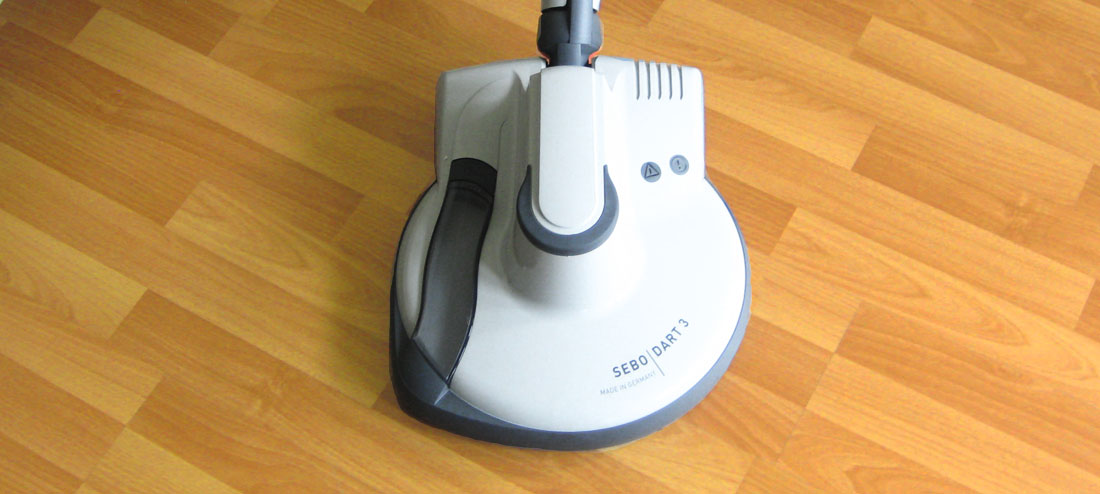
Laminate flooring is constructed of a number of layers that are bonded together by pressure and/or heat. A durable transparent surface layer of melamine resin resists scratching and staining and also protects the printed design layer below. The core is made of high density fibre or particle board, and the backing is a water resistant material, normally melamine resin or treated paper. Laminate is graded by its wear resistance.
The care of laminate flooring is very similar to wood. Wet mopping should be avoided as it could get into joints and then cause the underlying particle board to expand. Cleaning agents that have been specially formulated for laminate floors should be used.
Although hard wearing, laminate should be protected in the same way as wood floors with entrance mats and floor protectors on furniture feet. Like any other floor surface, the quality of the product will greatly affect its durability. A good quality laminate can be cleaned and brought to a high level of shine using a polisher fitted with standard or diamond pads.
Back to top
Ceramic and Stone Flooring Care
The most commonly used tiles are ceramic and porcelain which are made in completely different ways but are often confused.
Ceramic tiles have a durable surface glaze which carries the pattern and colour, below which is softer material often of a different colour.
Porcelain tiles are much denser, harder and are highly water resistant. The hardness and the colour normally go all the way through, so chips and damage are much less likely and if they do occur are less visible.
Care and cleaning of ceramic and porcelain tiled floors
As with all flooring, the best care is regular care. Vacuum at least once a week, more often for heavily used areas. A combination of grease, moisture, dust and fluff can turn into unpleasant grime if they are not efficiently removed. If the tiles are uneven, textured, or have wide grout gaps it is essential to vacuum with a combination head or parquet brush.
High gloss tiles can be polished with either standard or diamond pads, but avoid polishing uneven tiles as only the high points are polished. If tiles are used in a “wet” area of the home, they tend to be subject to different spills and spots. Mopping with hot water and a mild household detergent should remove most stains. If the stain remains stubborn, you can use a soft brush or synthetic scouring pad to loosen the spot, but do not use steel wool or a metal brush, as these may scratch the surface of the tiles. After washing a tile floor, be sure to thoroughly rinse the floor with clean water. This will remove any detergent residue from setting and attracting more dirt to your floor.
Grout
Although the tiles themselves may be impervious, the grouting between them is susceptible to staining as it is porous. To prevent staining use a good quality grout seal. Alternatively, if the grout becomes stained or discoloured, it can be brightened by a good cleaning with diluted bleach. Use the edge of a sponge or a toothbrush for this job, and be careful to keep the bleach solution away from other surfaces. Alternatively seek a specific grout cleaner.
Terracotta
Terracotta tiles do not have a surface glaze and so are highly porous. Without adequate sealing they will soak up stains and fail to be the beautiful floor they have the potential to be. They are also quite delicate, so should be cleaned with care. Seek advice when you buy the tiles about the best sealants and cleaners and consider using a professional for restoration and sealing of older floor.
Natural stone floors
A number of different stone types are used for flooring. Granite is the most hard-wearing and water resistant. Other stone types commonly used are marble, limestone and sandstone. Slate is often used in kitchens and bathrooms because of its water resistant properties, but has an uneven surface which means it must be vacuumed with a combination head or parquet brush. Porous stone should be sealed with an appropriate sealer.
Smooth, gloss natural stone floors such as marble and terrazzo can easily be maintained to a high standard using the SEBO polisher fitted with a diamond pad.
Back to top
Lino and Vinyl
Linoleum
True linoleum is a traditional, and some might say unfairly overlooked, flooring which is made from an environmentally friendly mixture of linseed oil, cork/wood flour, limestone and pine rosin which is pressed onto a jute backing. With known antimicrobial properties, linoleum comes in a variety of patterns and flecked designs, which can disguise scratches and marks. In addition, the pattern and colour go all through it which can reduce the visual appearance of floor damage. Although highly durable, linoleum can be damaged by moisture and alkalinity. Maintenance requirements are similar to wood, but in order to give its best appearance, to protect it from dirt and seal against excess moisture, linoleum should be cleaned and polished with products intended for use on genuine linoleum. Please consult the manufacturer for their specific recommendations. Most advise a regular polishing to renew linoleum's natural shine and stain resistance.
Vinyl flooring
Vinyl is a man made plastic material also called PVC. Good quality vinyl flooring, known as LVT (Luxury Vinyl Tile), can be beautiful, long lasting and ideal for kitchens and bathrooms. Because it is flexible it is also a good choice for installing on suspended floors which may have some movement. A durable surface layer is added to protect the underlying design and as with laminate, maintenance is similar to polyurethane sealed wood. Specific floor cleaners are available and information as to maintenance should ideally be sought from the supplier or manufacturer. Sheet cushion vinyl (where a thin surface layer covers a foam sub layer) can be one of the cheapest floor coverings available. Care has to be taken with this type of vinyl as it is relatively easy to damage.







